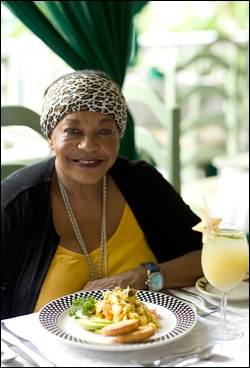The Flavor Of Jamaica
Felicia, a large, tall Jamaican woman, leaned over with amazing agility and enveloped me in her arms, my stiff white chef's coat crinkling in the embrace. "Thank you for teaching us about our food," she said, smiling. She was just one of many students of West Indian descent – mostly Jamaican – who took my cooking classes here in New York on how to prepare traditional meals.
I blushed and thanked her, thinking about her words. "Our food," she had said. But the truth was that, outside of my ancestral home of Trinidad, I was as much of a neophyte as the next cook when it came to the foods of the other islands. Most of what I knew of Jamaica came from childhood visits when my Trinidadian father took me to visit his closest friend, Lola Campbell, who lived in Brooklyn. Miss Lola was Jamaican and had, like him, come to America in the 1950s for education and the hope of a better life. When the two got together, there was always a feast of curries, stewed beef, rice and peas, and a sweet bread of some kind. Maybe there would be some ginger beer or a Red Stripe for my father. The day was punctuated by rapid-fire Caribbean patois and loud laughter.
Their camaraderie made me intertwine Trinidad and Jamaica so closely that, content with my once-removed knowledge, I never felt the need to visit Miss Lola's island home.
I was jolted out of my memories as everyone began departing the kitchen-classroom at the end of class. Felicia called out to me, "One love!" using the Jamaican saying. "One love!" I answered, raising my hand in a wave.
"One love!" I answered, raising my hand in a wave. Watching her disappear into the elevator down the hall, I knew that in order to live up to my students' admiration, I had to change my ways. Their belief in my ability to be the ambassador of the larger Caribbean made me long to know more about other islands that made up my West Indian heritage – and my first stop had to be Jamaica.
First Course: Patties & Patois
I arrive at the Kingston airport eager for my first taste of Jamaica and to expand my knowledge of Caribbean cuisine. My goal: take back to my cooking students the culinary essence of the island their forefathers called home.
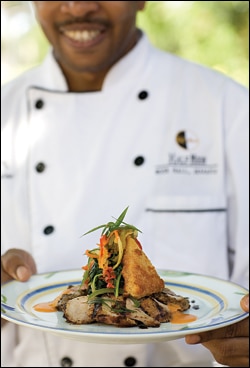
I am confident that my West Indian heritage will give me entrée here, but when I meet my guide, Carey Dennis, who will accompany me on this weeklong adventure, I am shaken by his formal, old-school British demeanor. As we head around Kingston Harbor, Carey recites that it is "the seventh largest natural harbor in the world" in proper tour guidese. I nod politely and look out the window at the street-food vendors that look so like those in Trinidad. They're selling green or "jelly" coconuts – bought for their cool water but so-named for their gelatinous flesh – and candies homemade from ginger and coconut. Peanut vendors are selling nuts wrapped in narrow paper cones rolled tightly so the salty, peppery nuts can be tipped right into the mouth. The fruit stands I see bring to mind all the fruits I can't get in the States.
"My favorite fruit is pommerac – do you have that here?" I ask.
"Pommerac," Carey muses.
"What does it look like?"
I launch into an animated explanation of the pinkish fruit with white flesh that tastes something like strawberry. As I form its shape with my hands, he suddenly bursts out, "Otaheite apple?!"
"Yes!" I say, "That's its real name. Captain Bligh brought it from the South Pacific." For the first time, Carey genuinely smiles.
"That's a real nice fruit!" he exclaims, and we start to talk about what else Bligh brought over, including breadfruit, a starchy tree fruit used as a filling staple to feed the slaves who were Carey's ancestors and, later, the indentured East Indians who were mine.
The ice has broken by the time we pull up to Devon House, the late-19th-century estate of Jamaica's first black millionaire and now a national monument. After a tour of the housemuseum with its wide plank floors and cedar- smelling antique wardrobes, so like those in my father's house in Trinidad, we stop at the Brick Oven, a patisserie in what was the estate's old kitchen. Here we pass by sweet rum cakes and pone, dense, syrupy cakes made from grated cassava. We order beef patties – a fitting starter to the coming days of indulgence – and eat them on a tree-shaded bench in the courtyard. They are as big as softballs and have flaky crusts. The spicy meat filling is good and hot, but not hot enough to stop me from gobbling mine down in five or six bites, chased with an ice-cold Red Stripe. Standing and brushing the pastry crumbs from our clothes, we head back to the car for our journey to Strawberry Hill, a mountaintop boutique hotel about 40 minutes north. As we pass through the city and up the hilly slopes, we see references to Bob Marley everywhere – his image on walls, his name given to everything from corner stores to schools.
This leads to a discussion of reggae, Trinidad calypso and more food. Carey tells me he is an avid home cook. Relaxed now, his language has eased into a light patois as we laugh through descriptions and anecdotes to try to learn what the same foods are called in our respective lands. The unspoken undertones of our easy conversation speak to a pact we are making as fellow island folk – one through which we will follow the story of our collective culinary heritage, hand in hand.
Second Course: Strong Drink
In the peaks, the next morning dawns bright and cool, belying the intense sun baking greater Kingston thousands of feet below. Carey sits across the table and sips his tea while I savor a cup of Blue Mountain coffee from Old Tavern Coffee Estate, just north of here. If a nation's essence were made up of aromas and tastes, surely Blue Mountain coffee would be a key part of Jamaica's. This brew's distinct flavor notes are complex and almost nutty, born from a berry slowly matured in the cool mountain mists and having a high sugar content.
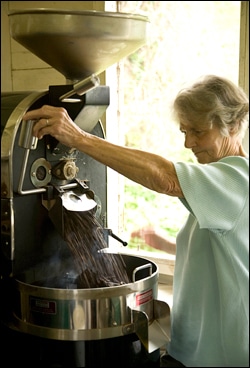
After breakfast we will trek further up into the Blue Mountains to Old Tavern, where Alex and Dorothy Twyman grow coffee beans, processing and harvesting in the traditional way, meaning by hand. This, combined with limited real estate for growing beans – Old Tavern grows their coffee at about 4,000 feet of elevation — means the coffee can retail for roughly $50 to $60 per pound in the U.S. If you don't know what you are looking for, Old Tavern, huddled on one of the many curves of a winding and dizzying mountain road, is easy to miss. The unassuming building has no sign, and Alex tells me, "That's how we like it. If you really want to find us, you will."
From inside, the rich smell of roasting coffee wafts through the window into the cool mountain air. Alex tells me Dorothy is roasting beans in small, to-order batches. Coming outside to greet me, Dorothy invites me back in, and I watch as she tastes a cup of coffee brewed from the beans she has just roasted. She does this with each order, using only the most aesthetically perfect beans for the premium coffee. The discarded beans with cracks or other imperfections are still usable and sold to a few local restaurants. Dorothy gives me a cup of just-roasted dark coffee. The aroma is heady. It's velvety on the tongue, sweetened not with sugar but with honey from Alex's bees, which are kept to pollinate the coffee flowers. He's rather enterprising. Later, I taste a coffee liqueur he makes with his beans and Jamaica's famous Appleton Estate premium rum (among others). I discover a more refi ned, artisanal version of the mass-market brands like Tia Maria.
I sip my coffee and take a cookie from the plate shyly offered by Dorothy. "We got these especially for you. They are from Trinidad." I nibble them while looking at the book of estate photographs with Alex. In the next room, Carey and the Twymans' grown son, David, are chatting about this and that. It's not unlike a lime at an old friend's house on my father's island. I wish I could linger here in this easy hospitality, but soon Carey gives a slight nod to indicate that it's time to head back down the mountain into Kingston and the next leg of our trip.
Third Course: A Fish Between Friends
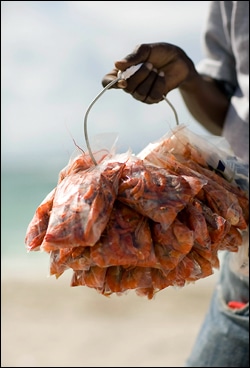
We journey out of kingston and head southwest toward the fishing village of Hellshire Bay, known for its beach-side food stands and bars. It is an extra stop on our longer journey. Boston Bay, considered to be the true home of jerk, is an inlet on the northeast shore in the parish of Portland, one of 14 such distinct areas of the island. Carey tells me that fish, too — prepared a myriad of ways — is yet another integral ingredient in the recipe that is Jamaica. Snapper, blackfin tuna, parrotfish, kingfish and more are roasted, steamed, fried, jerked, curried or pickled in the local escoviche style, using a vinegar-based marinade.
For a taste, we'll stop for lunch at Prendy's. At four years old, Prendy's is a newcomer to the cluster of established food huts in the Hellshire enclave, but it is already a hot spot because proprietor Donnette Prendergast hosts a dance party from Friday afternoon to Sunday evening. Today, a weekday, it is quiet, and I walk up to the counter to choose my fish from the fresh catch nestled in ice in a large cooler. I select a red snapper that I can have fried, roasted or steamed. "Fried," I say, as I join the cook in the kitchen, an open area with a long grill over a smoldering pimiento-wood fire. Taking up a long cutlass, the cook scrapes the skin to make sure no scales remain and then makes two slits on either side of the fish, into which he rubs a pinch of salt before tossing it into a vat of boiling oil.
"That's it?" I ask, amazed. In Trinidad, fish is usually washed with lemon juice and marinated in an elaborate sauce called "green seasoning," made of chopped herbs and garlic. "That's it," he says, scooping out my fi sh a few minutes later and handing it over on a plate with a side of bammy, a coconutmilk- soaked cassava cake that looks like a crumpet; and "festivals," a sweetened cornmeal fritter much like Italian zeppole. I slip into my place at a picnic table next to Carey and see he has chosen his fish steamed (which is actually simmered) with potatoes, carrots, okra, scallions, pepper, garlic, salt and a bit of pumpkin puree. It is arranged on a wide platter flanked by the large water crackers that are so popular here in Jamaica. My own fish, crispy outside and succulent within, is soon reduced to a pile of bones, and I eye Carey's plate hungrily. "Taste?" he asks, inclining his eyebrows a bit. "Do you mind?" I'm already picking up my fork. "Nah, man," he responds as I tuck into a bit of fish. It is delicate yet firm, like the friendship we're forming.
Fourth Course: Tableside and Roadside
Later in the car, we pass many vendors selling pan (barbecued) chicken and holding up bags of fiery peppered crayfish with bright red shells. Carey tells me we are invited to the home of his friend, chef Darren Lee, in Port Antonio, near our new hotel and a stone's throw from Boston Bay, also known as "the home of jerk." I realize I'm lucky to have a guide like Carey, who loves food and culture and keeps company in kind.
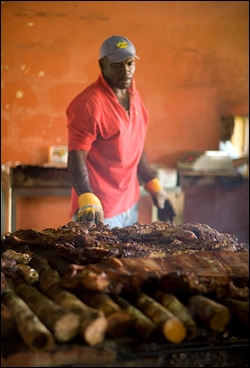
A Jamaican of Chinese descent, Darren has worked in America and in the finest restaurants around the island. When we arrive at his home, I see that – in true West Indian fashion – he has made more food than we can possibly eat. In an haute homage to local ingredients, there is tuna tartare made with local blackfin tuna atop reconstituted local sea moss (a dried seaweed) and a green salad with hibiscus dressing. What I'm really interested in, though, are the traditional dishes he has also prepared. There is curry goat, peas and rice and jerk chicken.
While we eat, Darren explains the holy trinity of ingredients that is the staple in nearly every type of Jamaican cooking: allspice, scallion and Scotch-bonnet pepper. He is animated as he talks, making comparisons to both Trinidadian food and our shared French culinary training so I may better understand. He also explains how this trinity is the starting point of jerk, a seasoning mix that can combine more than 20 spices and was created by the Maroons, escaped slaves who lived in the parishes of Portland in the Blue Mountains and cured wild hog meat that was then slowly smoked over a pimiento-wood fire. After emancipation in 1838, the Maroons were said to come down from the mountains to Boston Bay on Friday evenings, selling their smoked meats. Today, jerk stands dot the entire island, but the essence of true jerk is an elusive mix of spice and smoke that hard-core afi cionados, like Darren, claim is best found in Boston Bay. He recounts the tale easily, not just because it is part of Jamaican lore but also because he has grown up in this parish, where there is always a hint of jerk smoke in the air.
As he speaks, I find myself again wishing that I could stay talking long into the night, as with the Twymans. I like this man for his love of food and his love of country. "Will you come with us tomorrow? To Boston?" I blurt out. Across from me, Carey breaks into a wide smile. "Yes, can you come?" Now Darren smiles back, excited too. "Yes, I think I can." We spend the next half-hour negotiating when to meet and where we will go the next day.
True to his word, Darren meets us at our hotel the next morning, and together we make our way to a cluster of sheds called a "jerk center." It looks more like a huddle of falling down lean-tos than separate food stands. Emerging from the car, we see a band of rough-looking men, clothes smudged with blood and ash. We go to the largest of the stands, Mickey's, which is closest to the road. A steep hill slopes away from the building on one side. Two 10-by-10- foot grates are set side-by-side over the smoldering ashes of pimiento wood, stoked by a man wielding a longhandled shovel. On top of the grates are square pieces of galvanized metal upon which pork, chicken, sausage and fish sizzle, wrapped in foil.
I edge closer to the grates, and the men stand aside. Peering over the low wall and down the hill, I see a man making sausages, stuffing and twisting off the links by hand. I am the only customer and the only woman here. The men are clearly amused by this American lady come to have a look-see, and I am beginning to feel uneasy. It is clear that I do not belong here.
Darren tells them quickly in patois that I am a chef and a writer. With that, they nod warily. "She West Indian. Trinidadian," I hear him say, and they visibly relax. One man comes forward with some jerk chicken and roasted breadfruit on a plate. Another wields a bottle of pepper sauce, which I gladly take and pour out generously. "That too much!" he says, startled. "Nah, man," I reply and begin to eat. They watch closely to see if I will cough or sputter. When I don't, they smile broadly. The man with the pepper sauce asks if I like the jerk. "Yeah, man!" I say, grinning back.
Fifth Course: The Sweetest Taste
As we leave the jerk center, Darren asks if we have time for one more stop. I groan, unable to eat another bite, but he assures me that his is a lagniappe – or what we island folk call "a little something extra" – and this one is of the mental kind. He wants me to meet a master fish-pot maker in St. Ann's Bay, west of Boston Bay.
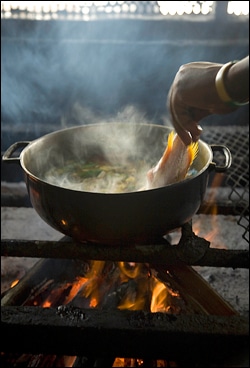
A traditional art, the fish pot is an ingenious, rigid net used by local fishermen that allows fish to swim in but not out. We pull onto a dirt road abutting the water. Small wooden huts are clustered together, and in a clearing near the shore a young man is winding chicken wire around a polygon made of bamboo sticks that will eventually be a fish pot.
Darren calls out to one of the huts, where a squat old man wearing a fishing cap sits inside on a small stool. I am introduced to Mr. Mack, a retired fisherman, now a master pot-maker. The boy outside is his apprentice. I glance inside the small hut at Mr. Mack, sitting among wire bales and bamboo sticks. I am reminded of my students back home and how I must faithfully record for them all I have seen here. I must share the smell of smoke from the roadside stands where fish, jerked meats and breadfruit are slowly roasting over pimiento wood fire. My words must convey the rise and lilt of my friends' voices standing a few feet away. Through my eyes my students will see young men sitting on a log close to shore, taking a break from making fish pots, laughing and chatting in patois, with the bottles of Red Stripe at their feet and the sea glittering beyond.
"Come inside, darlin'," Mr. Mack says, breaking my thoughts, reaching out toward where I stand on the threshold. Grasping my outstretched hand and drawing me near, he greets me in the old way: "I hope, now, we are not strangers?" "No, sir," I say, squeezing his hand. "No, we are not."
Photos by Shelly Strazis
